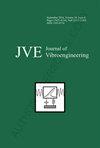Research on fault diagnosis method of electromechanical transmission system based on one-dimensional convolutional neural network with variable learning rate
IF 0.9
Q4 ENGINEERING, MECHANICAL
引用次数: 0
Abstract
As an important part of many mechanical equipment, the mechanical transmission system is very important to carry out efficient and accurate fault monitoring and diagnosis. Compared with traditional fault diagnosis techniques, such as spectrum analysis, deep learning has been widely used in the field of mechanical system fault diagnosis due to its powerful data expression ability, and has achieved certain research results. One-dimensional convolutional neural network is a widely used model for deep learning, so in this paper, the one-dimensional convolutional neural network (1D-CNN) in the deep learning theory and the vibration signal analysis method are integrated and applied to the fault identification of mechanical transmission system to achieve accurate diagnosis and classification of faults. The experiment is mainly to collect the vibration signal data of different fault states such as broken teeth, cracking, shaft unbalance, bearing wear, and excessive friction of the driven wheel of the mechanical transmission system, it was divided into training set and testing set according to an appropriate proportion, and 1D-CNN was built using Python. The deep learning model deeply analyzed the influence of different data sample sizes and different model parameters on the recognition accuracy, and obtained an ideal diagnostic model based on variable learning rate through parameter adjustment and comparative analysis. This experimental results show that the recognition method based on one-dimensional convolutional neural network can be effectively applied to the fault diagnosis of related mechanical transmission, and has a high diagnosis accuracy.基于变学习率一维卷积神经网络的机电传动系统故障诊断方法研究
作为许多机械设备的重要组成部分,机械传动系统对进行高效、准确的故障监测和诊断至关重要。与频谱分析等传统故障诊断技术相比,深度学习由于其强大的数据表达能力,在机械系统故障诊断领域得到了广泛应用,并取得了一定的研究成果。一维卷积神经网络是深度学习中广泛使用的模型,因此本文将深度学习理论中的一维卷积神经网(1D-CNN)与振动信号分析方法相结合,应用于机械传动系统的故障识别,实现故障的准确诊断和分类。实验主要是收集机械传动系统从动轮断齿、开裂、轴不平衡、轴承磨损、摩擦过大等不同故障状态的振动信号数据,按适当比例分为训练集和测试集,并使用Python构建1D-CNN。深度学习模型深入分析了不同数据样本量和不同模型参数对识别精度的影响,通过参数调整和比较分析,得到了一个理想的基于可变学习率的诊断模型。实验结果表明,基于一维卷积神经网络的识别方法可以有效地应用于相关机械传动的故障诊断,具有较高的诊断精度。
本文章由计算机程序翻译,如有差异,请以英文原文为准。
求助全文
约1分钟内获得全文
求助全文
来源期刊

Journal of Vibroengineering
工程技术-工程:机械
CiteScore
1.70
自引率
0.00%
发文量
97
审稿时长
4.5 months
期刊介绍:
Journal of VIBROENGINEERING (JVE) ISSN 1392-8716 is a prestigious peer reviewed International Journal specializing in theoretical and practical aspects of Vibration Engineering. It is indexed in ESCI and other major databases. Published every 1.5 months (8 times yearly), the journal attracts attention from the International Engineering Community.
 求助内容:
求助内容: 应助结果提醒方式:
应助结果提醒方式:


